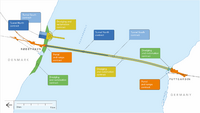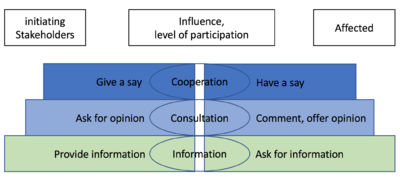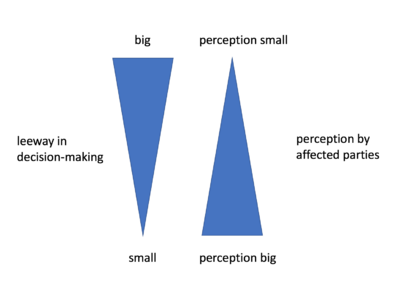Communication with public stakeholders on the femern link project in Germany
Developed by Matthis Hanstein
In the past major construction projects in Germany lead to conflicts between the public community and the project representatives. During the process of approving the permission for construction, these conflicts caused long delays, a rise of costs and decrease in the public acceptance.
To ensure a projects' good progress it is important for project managers to know how to handle the external communication. This article explains the way of communication with public stakeholders on large scale projects. It is a case study referring to the Fehmarn belt link project.
The fixed Fehmarn belt link will connect Denmark and Germany with a 18,2 km tunnel between Rødby and Puttgarden. The Project including the construction of 97 km of high-speed railway tracks in north Germany is one of the biggest construction projects in Europe planned at the time.[1]
Especially the German railway company Deutsche Bahn is in need to establish a new way of communication and public stakeholder relationship due to a couple miscarried major projects in the past few years. [1]
To avoid conflicts with public stakeholders the German federal ministry of transportation and the Deutsche Bahn, both stakeholders with financier interests, invented new ways of involving affected and opponent parties. In earlier projects, public opponents were only made participating as much as necessary by law. The new way of dealing with opponents is to involve and listen to them in order to find a compromise. [4]
So-called dialog forums to debate on a partnership basis were established. Former the project representatives only supported formal inquiries and fact-finding hearings. But to encourage the public debate and to reduce the opponent forces the initial stakeholders also organizes public meetings with citizen and municipality representatives. The current development and the progress in planning are constantly published on the website as well as on public meetings. [1]
That ables the public stakeholder to object their comments at a time when the planning is still able to be transformed on an easier way.
Contents |
The Project
The fixed Fehmarn Belt link will connect the Danish town of Rødby and the German island Fehmarn due to a 18,2 km concrete submerged tunnel. The goal of the biggest European construction project is, to shorten the distance between Scandinavia and the important markets in western Europe by 160 km. By connecting the metropolregion of Hamburg with the metropolregion of Copenhagen two of the most dynamic economical regions in northern Europe with over 9 Mio. people will be clustered. The estimated travel time by train between Hamburg and Copenhagen is supposed to be underneath 3 hours. [3]
The tunnel will contain two electrified railway tracks as well as a motorway with two lanes and side-strip per direction. [2]
The financing for the tunnel itself with 7.400 Mio. Euro and the back-country connection inside of Denmark with 1.200 Mio. Euro is managed by the state-owned Danish Femern A/S. These project costs will be brought in by toll fees within 36 to 42 years. The German 97 km high-speed back-country connection between Lübeck and Fehmarn with about 2.300 Mio. Euro will be paid by the federal republic of Germany. [1]
The opening of the project was first scheduled for 2021. Due to the amount of problems and concerns especially in Germany, the project is delayed and the opening got deferred to probably 2028. The start of the construction is now assumed to be in 2020. [1]
State of the art in public stakeholder relation
In the past, the general public has often first been aware of projects and its possible implications when a project is started to be built, leading to protests from affected residents, but also from parties not directly affected by the construction project. Their concerns are, for example, negative consequences for the environment. Environmental organizations often participate in protests against a project and try to stop it completely. Therefor antagonists from all over Germany find together. [5]
On the basis of such events, it becomes clear that a change in public participation of large infrastructure projects has to take place. Through an early the public participation, the objections of the citizens can be integrated relatively easy in the early planning of the project and thus lead to more acceptance among the opponents. This therefore can be regarded as quite positive. The formal public participation in the connection to the approval or plan approval procedure leaves only little room for change in planning. In this case, objections by citizens can not be taken into account, because once the procedure has been started, the initiators are seldom willing to consider other plans and implementing can be difficult. [4]
In May 2013, the Federal Republic of Germany reacted with a draft law on the problems described above for the first time. The "law for the improvement of the public participation and unification of the planning procedure", also the planning unification act, aims to harmonize the regulations and thus the implementation of the planning procedure. [7]
For that purpose the tool of early public participation has been developed. An improved communication between the population and the beneficiaries and a higher acceptance of the project shall be ensured through early public participation. [6]
Informal participation procedures
In order to understand the above-mentioned law, it is first necessary to clarify what can be imagined under an informal citizens' participation. Informal participatory procedures include the procedures which are not laid down in the law. [6]
| Forms and methods of informal citizens' participation: |
|---|
| Unconventional forms in the area of associative democracy |
| Cooperative forms in the area of participatory democracy |
| Forms of participation in the area of civil engagement |
In the unconventional form of participation, attempts are made to directly influence decisions by means of new, non-compiled forms. A large number of persons, e.g. as a citizens' initiative and try to implement this. The instruments of this form of participation include demonstrations and signatures. [6]
The aim of the cooperative form of participation is to influence the decision-making of political institutions of the executive and legislative branches. It can be initiated by the civil society, political institutions or other civil society actors. [6]
In the context of urban development and neighborhood planning in the 1970s, the new form of cooperation emerged between politics, administration, citizenship and parts of the economy. Since then, it has been developed in various subject areas and has produced a variety of instruments and methods. These can be used or linked, depending on the problem and the political situation. These include, for example, the methods of the future workshop and the future conference, the round table and mediation. For the legitimation of such procedures and, above all, the results, quality control must be carried out. [4]
Public Participation on the Fixed Fehmarnbelt Crossing
Interest in large-scale projects is growing among today's citizens. Accordingly, the resistance increases. As mentioned above, in the past, there have been frequent escalations of disputes over large projects. The extent of such conflicts can be particularly clearly seen in the example of Germanys "Stuttgart 21". Summiting 2010 with fights between the police and demonstrating citizens. [9]
In 2011, one year after "Stuttgart 21", the Dialogforum for the Fehmarnbelt link was set up by the state government of Schleswig-Holstein. Participants had the opportunity to make recommendations. Results from the Forum have been included in the Federal Transport Plan 2030. The Dialogue Forum accompanies the whole process of implementation, including formal administrative procedures. [9]
Functions and objectives of the citizens' participation
The aim is to ensure that citizens' participation is carried out at an early stage and continuously at all stages of the process. The aim is to stabilize the participation of citizens through all procedures of approval. The focus should be to ensure participation in decision-making process before the formal participation procedure. [4]
| The following objectives and functions can be attributed to the participation of citizens: [4], [5], [6], [10] |
|---|
| Citizens are integrated into the planning and decision-making process. For example, by accessing the documents they will be given the opportunity to understand and influence the planning and decision-making process |
| Citizens can also raise their concerns and ideas in the run-up to the participation in the planning process and thus to optimize the planning |
| Participation enables citizens to better understand the context and the background of the process |
| The legitimacy of the planning and decision-making process is increased, if citizens' objections are taken into account in the decision-making process or, if they are not taken into account, a good justification is given as to why other interests were more important in the overall balance |
| Judicial disputes can be avoided by the early detection of conflicts and corresponding plan adjustments, whereby procedural delays can be reduced by subsequently required changes |
In addition to these points, citizens' participation can also contribute to increasing public confidence in public administration and politics, promoting democratic understanding and improving the level of information available to the public. [6]
Actors of participation
The concept of participation involves the participation of citizens in planning and decision-making processes. Actors within traffic route planning are the "Affected parties" and other "Participants" on the one hand and the "Initiating stakeholders" on the other. [6]
| The "Affected" is everyone whose interest will be effected by the project. "Public concerned" means any person whose interests may be affected by an approval decision or planning, and also includes (environmental) associations. |
| "Participants" are citizens as well as collective actors such as associations, interest representatives and municipalities, who are involved in the planning and decision-making process and the development of the project. |
| "Initiating stakeholders" are actors, such as administrations or authorities, who are in the position to submit offers of participation and are thus responsible for the granting of participation. In public licensing procedures, the parties involved are either the planning authorities or the authorities responsible for the administrative procedure. |
Levels of participation
This basic distinction between stakeholders and their possible activities at various levels of participation is explained in the following figure.
Different degrees of participation can be distinguished: the higher the level, the greater the extent to which the stakeholders are allowed to participate, and the greater the degree of participation by the participants [8]. The possible participation ranges from the information on the consultation to the cooperation. However, in the case of the approval of transport projects, the actual decision is the responsibility of the relevant federal authorities. [4]
Information is the form of the participation, the information transfer and inclusion. Communication is predominantly in one direction, namely from the initiator and the authorities to the citizens. For information, such as project brochures, mail dispatches, announcements, internet pages, telephone information services, information events and planning exhibitions. [6]
Consultation means that affected parties can take an active part and express their opinions. Communication between decision-makers and citizens is reciprocal. Participation in the implies that there is a bilateral communication between affected parties and initiating stakeholders. During the consultation, such as statements, written and oral interviews, Internet forums and citizen meetings. [6]
Cooperation means that the affected parties are involved in the planning. Nevertheless, the actual decision takes place in the planning procedure. As part of the cooperation, it is particularly important to point out to the citizens at an early stage which questions are in the planning process for the decision in order to not arouse false expectations and to prevent misunderstandings. Communication between the persons involved is intense. Possible methods are, for example, e.g. round tables and dialogue forums as well as mediation procedures. [6]
Progress of participation
Although existing law provides formal participation in traffic route planning, but these are often perceived as inadequate by the affected citizens.
| The following decisions are criticised by citizens, associations and parties: [4], [6], [10] |
|---|
| Citizens would not participate directly in the basic decision on the need for a project |
| The restriction of the participation in the formal and timely procedures leads to the fact that the citizen is no longer openly and seriously discussing the advantages and disadvantages of the project or project alternatives. |
| The participation is too late, at a time when the project has already achieved a spatial and design-technological conception, and the willingness of the initiating stakeholders to make changes is small |
| Outside of formal procedures, citizens lack the opportunity to take part in planning documents and to inform themselves about the planning and decision-making process, to comprehend it, to ask questions of understanding and to participate |
Success factors of good participation
The quality and the framework conditions of the process are important for a successful participation of the citizens. The creation of more opportunities for participation is not sufficient enough to achieve the desired positive effects. [8]
The accessibility and publication of qualified information is a first basic requirement for the third affected to deal with the project. The information needs to be carefully selected and prepared. In order to publicize the information, it is useful to use different media in order to reach different groups, possibly via target group-specific information channels. [4]
In addition, a solid basis of trust and a process which appears to be fair are also essential for a successful participation, both with regard to the approach, the personal interaction with each other, and the result. A respectful approach not only has a positive effect on the trust between the actors but also an important basis for a perceived fair relationship between initiating stakeholders and affected parties. Accurate information, as well as a transparent approach, facilitate the exercise of fair action. Likewise, a balanced distribution of effort and benefit from the perspective of all involved is the basic prerequisite for the perception of a fair process result. [6]
Timeliness, sincerity, fairness, open-mindedness and target-oriented approach are success factors of good participation. [4], [12]
The choice of affected parties should not exclude other participants. In addition to those who were negatively affected by the project, the basic advocates of a project should also be involved. Participation of project advocates can create a mutual understanding through the exchange of interests and concerns, thus improving the process. A balanced discussion of the pro and contra arguments should be the goal of a participation process. [6], [11]
However, acceptance can only be achieved if the persons concerned are also practically enabled to participate. In addition to adequate information and the concession "to be able to participate", this includes understanding the facts as well as the ability to express themselves so that their own concerns are actually heard. A lack of these competencies, combined with perceived emotions, can often lead to feelings of impotence among those affected. Measures which promote the ability to participate are, for example, such as information events, citizens' talks, question-and-answer sessions, as well as the provision of a process guide that makes difficult situations clear to citizens without specific knowledge. [6], [8]
Summarization and Conclusion
| In summary, the following factors should be taken into account: |
|---|
| Open and appreciative basic attitude - The participation is based on the mutual trust of the actors and is characterized by a respectful and correct approach. All participants face each other on the same level. The citizen's concerns are taken seriously. |
| Earliness - Participation takes place at an early stage when there is still room for decision-making and the entire course of the planning and approval process. |
| Active involvement of all stakeholders - Sincere participation requires a corresponding attitude among the participants. The affected parties feel the difference between the parties' authenticity and the seriousness of their participation, or whether they are used exclusively as a means of pacification. |
| Independent moderation - The selection of the participants is based on a well-founded determination of the potential target groups (actor analysis), no group of interest is excluded. |
| Information - The necessary information are accessible to all and generally be addressed to a target group-oriented approach. |
| Clear objective - The participation process is result-oriented and planned in advance. Responsibilities, premises, finances, administrative procedures and actors are determined or organized at an early stage. |
Annotated Bibliography
- Public Participation Manual, Lucerne University of Applied Sciences and Arts, http://www.alpine-space.org/2007-2013/uploads/tx_txrunningprojects/Demochange_Public_Participation_Manual.pdf
- Manual for Good Public Participation, Federal Ministry of Transport and Digital Infrastructure, https://www.bmvi.de/SharedDocs/EN/Documents/VerkehrUndMobilitaet/manual-for-good-public-participation.pdf?__blob=publicationFile
- VDI-Richtlinie: VDI 7001 Kommunikation und Öffentlichkeitsbeteiligung bei Planung und Bau von Infrastrukturprojekten - Standards für die Leistungsphasen der Ingenieure
- Leitfaden für eine frühe Öffentlichkeitsbeteiligung, Bezirksregierung Köln, https://www.brd.nrw.de/umweltschutz/pdf/Leitfaden-fruehe-OeB.pdf
References
[1]: DB: Schienenanbindung der Festen Fehmarnbeltquerung 01.10.2017
[2]: Tunnel: Feste Fehmarnbelt-Querung: Daten und Fakten zum Projekt 01.10.2017
[3]: Femern A/S - Der Fehmarnbelttunnel (Hrsg): Meilensteine auf dem Weg zum Tunnel, o.J. 01.10.2017
[4]: Dr. Schwab J., Leitfaden für eine frühe Öffentlichkeitsbeteiligung 01.10.2017
[7]: Innenministerkonferenz, Beschlüsse 2016
[8]: http://kommunalwiki.boell.de/index.php/Bürgerbeteiligung
[9]: Lüttringhaus, M., Handbuch Aktivierende Befragung. Konzepte, Erfahrungen, Tipps für die Praxis. Verlag Stiftung Mitarbeit: Bonn 2003
[10]: Das 3x3 einer guten Öffentlichkeitsbeteiligung bei Großprojekten, Bundesumweltministerium, 2017
[11]: VDI-Richtlinie: VDI 7001 Kommunikation und Öffentlichkeitsbeteiligung bei Planung und Bau von Infrastrukturprojekten - Standards für die Leistungsphasen der Ingenieure



